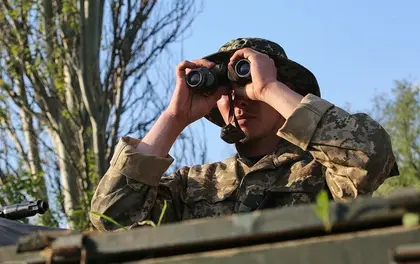The latest frenzy was triggered this week by drone footage purporting to show a secret Russian base quickly built up in a prime position from which to launch an attack on Mariupol in southern Donetsk Oblast.
Ukraine’s volunteer Dnipro-1 Battalion released the footage on June 30 showing the base, which appears to have been constructed within the span of two weeks, and which has new roads, trenches, a parade square, and protective dugouts and constructions to hide the tanks and military vehicles shown there. The video was shot on June 4 above the village of Sontsevo – just 12 kilometers from Ukrainian positions on the front line.
JOIN US ON TELEGRAM
Follow our coverage of the war on the @Kyivpost_official.
Many have pointed to the footage as proof that Russia is planning an offensive on Mariupol, citing the location of the base – right between Ukrainian-controlled Volnovakha and separatist-occupied Telmanovo – as clear evidence that separatist Russian forces are getting in position to cut Mariupol off from Ukrainian reinforcements to the north.
But there’s one problem: The base is not so secret. Foreign journalists were even allowed to visit it and watch military exercises there held in May, according to British journalist Oliver Carroll, who saw it for himself.
The hysteria the base has triggered is just part of a long game, and Russia’s wider psychological war against Ukraine, analysts told the Kyiv Post.
While the new base is highly sophisticated, it isn’t quite the smoking gun that is being portrayed as, according to Oleksiy Melnyk, a military expert at the Kyiv-based Razumkov Center think tank.
The fuss over the base “is slightly overestimated,” Melnyk said, noting that there was no solid proof it was actually constructed by the Russian Army.
“Something like that could be made by any educated military engineer,” he said.

“Every day we hear that ‘there will be an attack here, there will be an offensive there,’ but that is part of Russia’s goal, to keep hinting at aggression and sowing panic.
“Repeated declarations by government officials that there will soon be an attack only serve to weaken Ukraine,” he added.
In fact, the chances of an attack on Mariupol are “pretty low,” Melnyk said, adding, however, that this doesn’t mean there will not be an offensive, but that Russia is seeking to create paranoia and unpredictability to keep the Ukrainian military on its toes.
Alarm over imminent attacks has so far proven to be a constant in the war, with armchair analysts all over the world joining the chorus of soothsayers trying to predict the next major battle. Predictions on the takeover of Mariupol have been offered almost nonstop in recent months, and it doesn’t help matters that Kremlin-backed separatist leader Alexander Zakharchenko has repeatedly vowed to take the city.
The closest thing to a full-blown offensive came early last month in Maryinka, a few kilometers west of the city of Donetsk, when Ukraine’s military reported that more than a thousand combined Russian-separatist forces tried to encircle Ukrainian troops in what was thought to be a bid to seize the town.
But it seems increasingly likely that that was never their intention, as soldiers on the ground in that fight told the Kyiv Post it seemed more like the Russian forces were there just to toy with them – to test their capabilities.
That battle, like many others in this war, is more likely part of a long game to slowly and methodically wear down Ukrainian troops – both physically and psychologically – by waging a series of minor attacks and seemingly pointless incursions to create an all-encompassing atmosphere of paranoia and uncertainty, says Vitaly Bala of the Situations Modeling Agency think tank.
Get Ukraine to cry wolf enough, and no one will pay much attention when they turn out to be right, Bala said.
The constant speculation about a major offensive is just as damaging to the country as a real battle, Melnyk said.
“Even the low chance of an offensive carries a huge risk for the country,” he said, adding that such fears damage both the economy and morale.
Bala agreed that the unrelenting frenzy about impending attacks was just Russian psychological warfare in action – and it was as much about impressing Russia’s domestic audience as about keeping Ukraine on its knees.
“All of these statements solve one simple problem for Russia: They let the Kremlin show all other countries that the Russian Empire is alive and well,” Bala said.
“They want to make Ukraine out to be a weak country that is dependent on Moscow, so they are trying to weaken it from the inside,” he said, adding that the biggest threat to stability in Russia was a “successful Ukraine.”
As soon as the military action stops, the conflict will become frozen, Bala added. “The war will ebb and flow and keep going because all these men armed and backed by Russia have nothing else to do with themselves.”
The Kremlin’s main goal now is to “keep the Donbas in a chokehold that will keep pulling Ukraine back,” Bala said. “And they won’t voluntarily release that chokehold. Someone needs to force them to do it.”
Kyiv Post staff writer Allison Quinn can be reached at a.caseyquinn@gmail.
You can also highlight the text and press Ctrl + Enter




